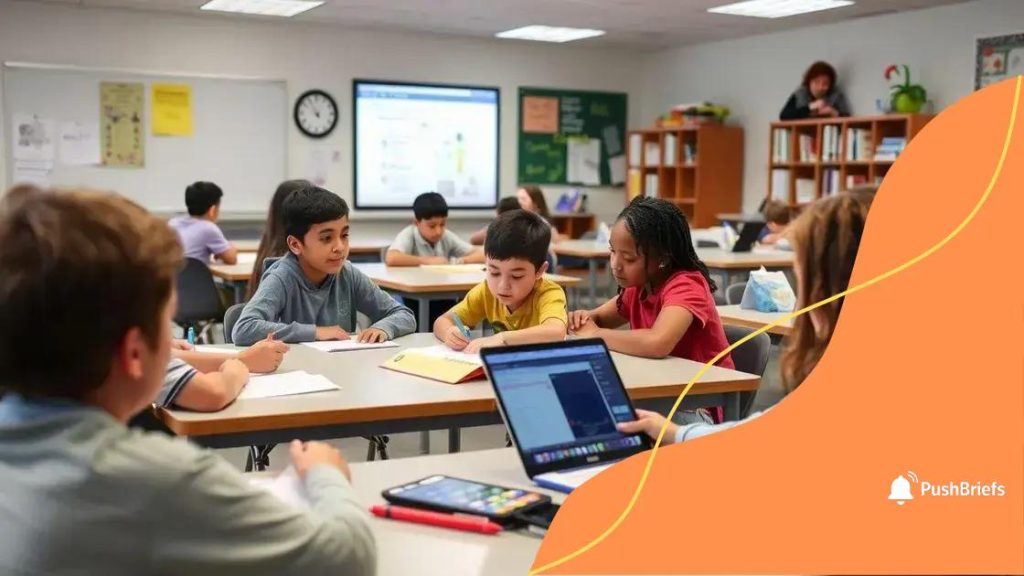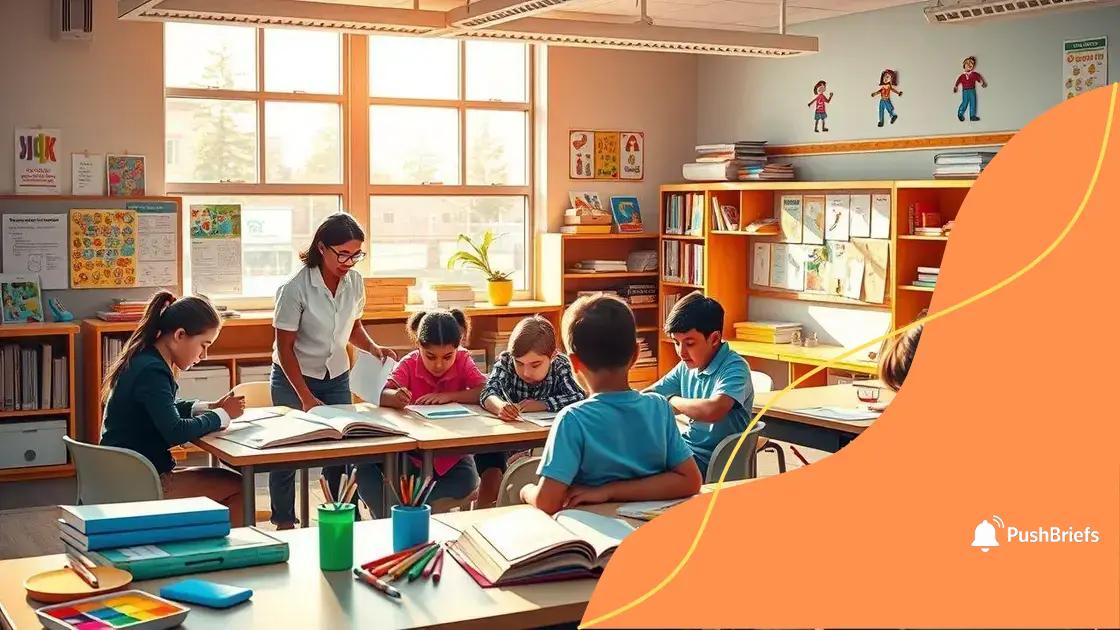Competency based learning: unlocking personalized education

Competency based learning focuses on student mastery of skills, allowing personalized educational experiences where progress is based on individual performance rather than time spent in the classroom.
Competency based learning is reshaping the educational landscape by focusing on individual learning progress rather than time spent in class. Have you ever wondered how this approach can change the way we view education?
Understanding competency based learning
Understanding competency based learning is essential for grasping its impact on education. This approach allows students to progress based on their abilities rather than the time they spend in the classroom.
Traditionally, students move through courses at the same pace. However, competency based learning changes this by focusing on mastery of specific skills. This ensures that students are fully ready before they advance, leading to deeper understanding and retention.
Key Principles of Competency Based Learning
There are a few key principles to keep in mind:
- Students progress at their own pace.
- Emphasis on mastery of skills over seat time.
- Personalized learning experiences.
- Frequent assessments to gauge understanding.
In a competency based learning environment, each student can engage with material in a way that suits their learning style. This might mean spending more time on challenging subjects or advancing quickly through topics they find easier. For example, a student may take a month to master algebra while another might only need a week. The focus here is not just on passing classes, but genuinely understanding the material.
Benefits for Students
A major benefit of this approach is the flexibility it provides students. They can dive deeper into subjects that interest them, which promotes a love of learning. Competency based learning also fosters responsibility, as students take charge of their educational journey. They are encouraged to set their own goals and track their progress.
Moreover, the accountability built into this system prepares students for real-world challenges. For instance, they learn how to manage their time effectively and assess their understanding continuously. This prepares them not only academically but also personally and professionally for the future.
By adopting competency based learning, schools are not just changing the educational framework. They are evolving to provide a learning experience that meets the diverse needs of all students.
Key benefits for students and educators
Exploring the key benefits of competency based learning reveals how it transforms the educational experience for both students and educators. This method creates a more personalized environment that enhances engagement and effectiveness.
One significant benefit is increased student motivation. When learners have the freedom to progress at their own pace, they often feel more in control of their learning journey. This leads to a greater sense of ownership and responsibility. In turn, motivated students are more likely to engage deeply with the content.
Advantages for Students
Students experience multiple advantages, including:
- Customized learning paths that fit individual needs.
- Increased retention of material through mastery.
- Greater flexibility in managing their own learning schedules.
- Development of critical skills, such as self-assessment and goal-setting.
This flexibility allows students to take the time they need to truly understand complex subjects. For instance, a student struggling with fractions can take additional time, while a peer who excels can move on. This kind of differentiated learning supports diverse learning styles, facilitating a richer educational experience.
Benefits for Educators
Educators also see clear advantages with competency based learning. They can better tailor their teaching methods to meet the needs of each student. This leads to more effective teaching strategies and improved student outcomes. Furthermore, teachers can focus on facilitating discussions and providing support rather than merely delivering content.
By using assessments to guide their teaching, educators gain valuable insights into student progress. This information allows for immediate adjustments in instructional strategies. As a result, educators become more responsive to student needs, which ultimately enhances the learning environment.
Competency based learning creates a win-win situation for both students and teachers. With personalized experiences and targeted feedback, everyone involved benefits from a more dynamic and effective educational system.
How to implement competency based learning

Implementing competency based learning can transform educational settings for both students and teachers. This approach requires careful planning and execution to create a supportive environment that promotes mastery.
The first step in this process is to define the competencies clearly. This means outlining the specific skills and knowledge that students need to demonstrate. For instance, a math curriculum might include competencies such as problem-solving, understanding geometric principles, and applying algebraic concepts. When these competencies are well-defined, it becomes easier for both educators and students to focus on learning outcomes.
Creating a Flexible Learning Environment
Next, it’s essential to establish a flexible learning environment. This includes allowing students to work at their own pace. Some students may need more time to grasp challenging concepts, while others might advance quickly. Teachers can support this flexibility by:
- Using varied teaching methods to cater to different learning styles.
- Providing access to resources like online tutorials and study groups.
- Creating a safe space for students to ask questions and seek help.
Additionally, regular assessments play a crucial role in competency based learning. These assessments should be designed to evaluate whether students have mastered the required competencies before moving forward. Formative assessments, such as quizzes and peer reviews, can provide ongoing feedback. This helps educators adjust instruction as needed, ensuring that all students are progressing appropriately.
Engaging Students in the Learning Process
Another important aspect is to engage students actively in the learning process. Teachers can encourage this engagement by fostering a sense of community among students. Group projects and discussions can help students learn from one another, enhancing their understanding of the material. Competency based learning also allows for more personalized feedback, which can motivate students to take greater ownership of their education.
Moreover, it is beneficial to involve students in setting their own learning goals. When they feel invested in their objectives, they are more likely to stay motivated and committed to their studies. This approach creates a more collaborative classroom atmosphere where students feel empowered to seek challenges and take risks in their learning journey.
Challenges in adapting to competency based learning
Adapting to competency based learning presents various challenges for both educators and students. Understanding these challenges is crucial for successful implementation.
One significant hurdle is the need for educator training. Many teachers are accustomed to traditional teaching methods, which focus on time-based learning. Transitioning to a model that emphasizes skill mastery requires professional development. Teachers must learn how to create competency frameworks and tailor their teaching strategies accordingly. Without proper training, the effectiveness of competency based learning may be limited.
Resistance to Change
Another challenge stems from resistance to change. Students, parents, and even educators may have difficulties accepting this new approach. They might worry about how grades will be assigned or if the new system will adequately prepare students for future academic challenges. This apprehension can hinder the implementation process. Open communication and education about the benefits of this model are essential to alleviate concerns.
Furthermore, adapting current curricula can be complex. Many existing programs are designed around traditional, time-centric methods. Revamping curricula to align with competency based standards takes time and resources. Schools must evaluate existing materials and develop new assessments that reflect true mastery rather than mere completion of tasks.
Ensuring Consistent Assessment
Creating consistent and meaningful assessments can also be challenging. In a competency based learning model, assessments must accurately measure student proficiency. This requires ongoing feedback mechanisms and revisions to assessments to ensure they align with learning objectives. Educators may struggle with designing assessments that not only evaluate knowledge but also practical application of skills.
Lastly, managing student motivation and engagement can be difficult. While many students thrive under a self-paced approach, others may lack the discipline to keep progressing. Teachers need to implement strategies to motivate all learners, ensuring they remain engaged and committed to their educational journeys. This may include goal-setting sessions, regular check-ins, and fostering a supportive learning environment.
Future trends in personalized education
The future of personalized education is shaped by competency based learning and technology. These trends are redefining how education is delivered, making learning more engaging and effective for students.
One emerging trend is the integration of technology into personalized learning. Tools like adaptive learning software allow students to learn at their own pace. This technology often uses algorithms to assess a student’s strengths and weaknesses, tailoring content accordingly. As a result, students receive customized feedback that helps them focus on areas that need improvement.
Data-Driven Insights
Another significant trend is the use of data analytics to inform instructional practices. Teachers can track student progress using real-time data. This information helps them adjust their teaching strategies and provide targeted interventions. By analyzing patterns in student performance, educators can identify which teaching methods are most effective.
- Data helps personalize learning experiences.
- Identifying student trends allows for timely support.
- Feedback can be immediately incorporated into lessons.
As data becomes more accessible, educational institutions will be better equipped to create a responsive learning environment. This shift fosters a deeper connection between students and educators as communication becomes more focused on individual needs.
Collaborative Learning Environments
The future also emphasizes collaborative learning experiences. Students will increasingly work together on projects that encourage teamwork and problem-solving. These projects not only enhance the learning experience but also prepare students for real-world challenges. Educators will facilitate group work and discussions, guiding students to learn from one another.
Furthermore, competency based learning encourages learners to take ownership of their education. By setting personal learning goals, students become more invested in their success. They develop critical skills like self-regulation and time management, which are essential for lifelong learning.
In this evolving educational landscape, the integration of personalized approaches through competency based learning, technology, and collaboration will make education more accessible and effective. This future is bright for both students and educators as learning continues to evolve.
In conclusion, competency based learning is reshaping education in exciting ways. This approach makes learning more personalized and effective for every student. By using technology and focusing on individual strengths, students can achieve mastery at their own pace. Educators play a crucial role by guiding students through this adaptable learning process. As we look to the future, embracing these trends will help create a more engaging and supportive educational environment for all.
FAQ – Frequently Asked Questions about Competency Based Learning
What is competency based learning?
Competency based learning is an educational approach that focuses on enabling students to progress based on their mastery of specific skills and knowledge, rather than the time spent in class.
How does technology assist in competency based learning?
Technology supports competency based learning by offering adaptive learning tools that tailor educational content to each student’s needs, helping them learn at their own pace.
What are the key benefits of competency based learning?
Key benefits include personalized learning experiences, increased student engagement, improved mastery of content, and more effective teaching methods for educators.
What challenges might schools face in implementing competency based learning?
Challenges can include resistance to change from students and educators, the need for educator training, and the difficulty of revising curricula and assessments to align with competency based standards.
